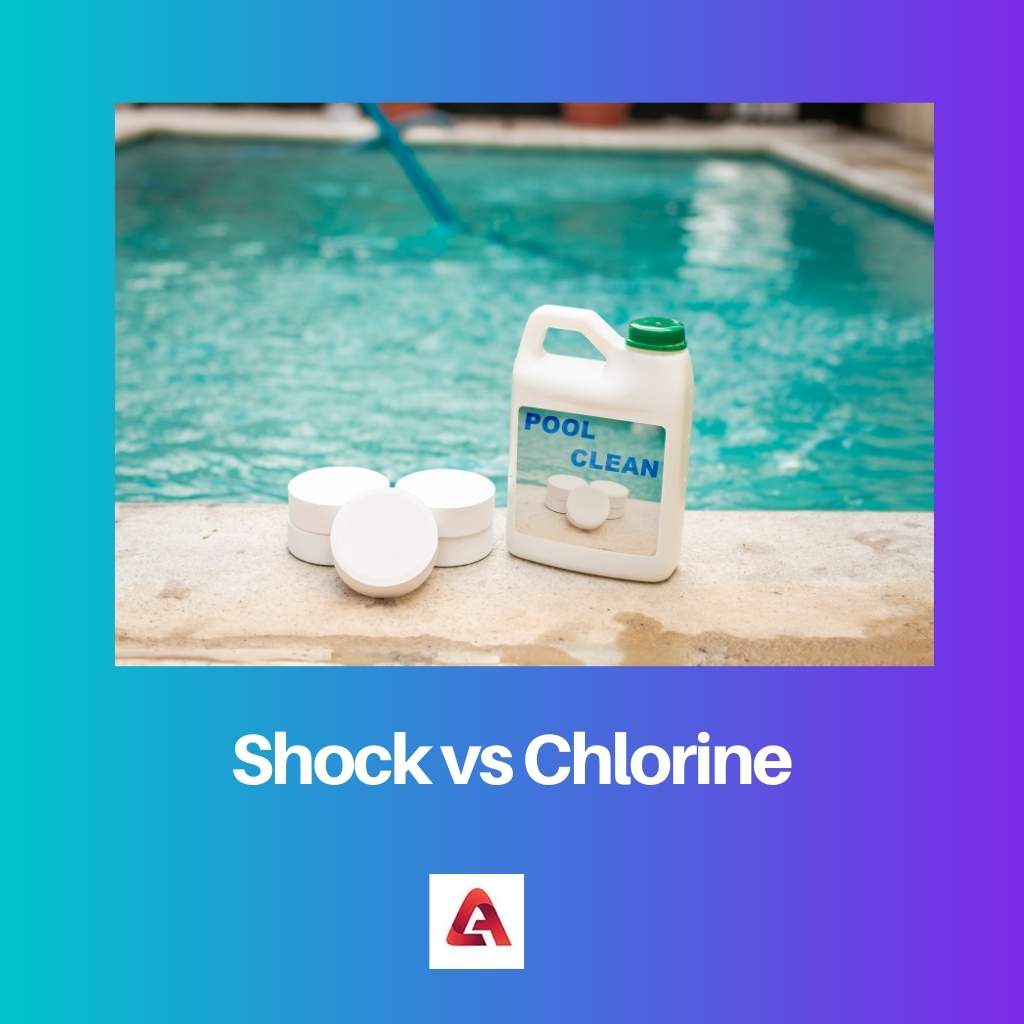In the abstract, Chlorine is an element with the atomic number seventeen and the second lightest halogen in the periodic table.
Key Takeaways
- Shock is a chemical used to sanitize and oxidize swimming pool water by breaking down organic contaminants. At the same time, chlorine is a chemical that kills bacteria and other microorganisms in the water.
- Shock is used to eliminate algae and bacteria buildup, while chlorine is used to maintain water hygiene.
- Shock treatment is done periodically, while chlorine is added regularly to maintain a certain chlorine level in the pool.
Shock vs Chlorine
Shock chlorination is the process responsible for killing algae and bacteria in swimming pools by adding a large volume of chlorine. It contains 12.5% sodium hypochlorite that acts as a disinfectant in water. Chlorine dissolves chlorine gas in water to disinfect swimming pools and drinking water.

Shock is also known as shock chlorination, a process of reducing the bacteria and algae residue in swimming pools, water wells, springs, and other water sources.
On the other hand, Chlorine is a chemical element which is used as a primary component in the disinfection process. Apart from cleaning pools, chlorine is also used to treat drinking water.
Comparison Table
| Parameters of Comparison | Shock | Chlorine |
|---|---|---|
| Definition | It is a process of adding chemicals like- chlorine or non-chlorine to the water, that eliminates the free-chlorine level and develops chloramine ten times the water. Shock chlorination is mostly done in swimming pools. | Chlorine is the process of dissolving chlorine gas in water to form an equilibrium mixture of three chemicals- chlorine hypochlorous acid, and hydrochloric acid that kills microbes in the water. |
| Formation | The shock comes either in liquid or powder form, which has 12.5% sodium hypochlorite, which augments chlorine level to 5-10 ppm. | Chlorine forms the hydrogen and hydrochloride ions that are later dissociated, to make the water high-degree of acidic for the microbe killing. |
| Components | Three components are used to engender shock in the water such as sodium di-chlor, Calcium hypochlorite and potassium monopersulfate that comes in granular form. | There are three components used to form chlorine such as chlorine, hydrochloric acid and hypochlorous acid. |
| Purpose | Shock is used in the pool or any water bodies in order to cleanse, accelerate the free-chlorine level that sanitises the water, dissipate all the bacteria and present lucid and crystal clear water. | Chlorination is used to kill the microbes in the water bodies and also PVC. |
| Reaction | Adding shock to the water, gives the reaction of disinfectant active chemicals and eliminates the free-chlorine level and increases the chlorine level to 5 ppm and above. | Chlorine works as an efficient halogen that helps to break the bonds in disease-engendering pathogens with a small concentration of chlorine and more acidic reaction aids to eliminate germs. |
What is Shock?
Shock chlorination is a process of adding a huge amount of chlorine to reduce the presence of bacteria and algae in water bodies, especially in swimming pools.
Shock is recognized as a strong concentration of 12.5 per cent sodium hypochlorite, which reacts with water to form an active disinfectant chemical in the pool.
Shock is made by adding a concentrated chlorine solution to the water in any water body. This concentrated water is sent to the aquifer and then passed through the system to sit for a certain amount of time for disinfection.
Moreover, only a certified well driller can use Shock to remove bacterial traces from water bodies, like pools, wells, well casings, and tanks.

What is Chlorine?
Similarly, chlorine is also a major element used in disinfecting water bodies and drinking water.
However, unlike shock, water chlorination is a process done by dissolving chlorine gas in water to form an equilibrium mixture of chlorine, hypochlorous acid, and hydrochloric acid to kill microbes in the water.
Chloramines are very small concentrations but are widely used in generating germ-free water. Back in 1894, a paper published an article on adding chlorine to water for a germ-free environment.
Subsequently, Chlorine has been regarded as an efficacious halogen that can break the bonds in disease-engendering pathogens. Besides, chlorine is also used to treat drinking water.
On the whole, chlorine is used to disinfect water bodies as well as to manufacture paper, paints, textiles, insecticides, and PVC.

Main Differences Between Shock and Chlorine
- Shock is used to increase the level of free chlorine in the water bodies, which makes the water pure and clear. On the contrary, Chlorine is employed with the aim to disinfect the water as well as kill the bacteria or germs in the water bodies.
- When the shock chlorination process is implied in the water, it will show the reaction of an increase in the chlorine level to 5 ppm or above.




